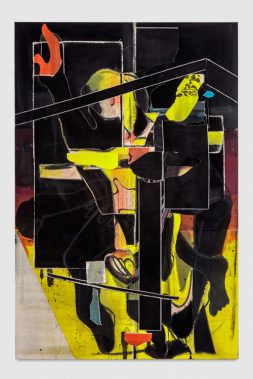David Hendren
Land of LensLos Angeles | August 26 - October 15 2017
Press: Curate


EG: Tell me about the title.
DH: I was driving across Oklahoma last summer and heard this hymn on the radio titled "Land of Rest". It was in the afternoon, and there was this beautiful thunderstorm, gray clouds. I tried waiting out the storm under an overpass, but ended up falling asleep.
AF: This process of naming a place and its commonality that you note, provides a means by which we ground the concept from a space to an abstraction. What is this "Land" in your title?
DH: The hymn was the soundtrack to a complete world, one suggested by the hymn's title, like an announcement for the land I had entered. These long, drawn-out organ chords, rain on the metal roof, thunder and lightning. And yes, the "Land" grounded the experience into an observable place. I didn't realize it at the time, but this experience was the genesis of the show.




CH: When we talked, you mentioned two experiences that anchor your thoughts on this show. This world of hymns and rain you encountered on the road, and these performances you did of your music. And there's this transition that follows these experiences, one from rest to anxiety.
DH: That's right. When I woke that night of the storm, I drove down the highway a few miles and pulled into one of those chain truck stops. I heard a guitar from behind the truck stop, walked around back and found a nearly empty stage. Just a guy sound checking a guitar. He looked at me and gestured for me to come up and play. So I played. There was this illuminating anxiety to the whole experience.
CH: As artists, we're at rest when we're anxious. Otherwise we're not doing the work.
DH: Hatching an idea, or getting inspired or whatever you want to call it, that's the restful moment, like you say. You finally know what you're doing. And if there's any teeth to the idea, unpacking it should cause some discomfort. A friend of mine says that art and anxiety are the same thing. I think good ideas follow a cyclical pattern of inspiration and fear.
EG: But what of the "Lens"? We talked about the two-way nature of looking into the world. Seeing and being seen.
DH: There's this re-directed gaze when you perform versus present objects, and thus a re-examination of where the art is located. I'm questioning my limits, and the lens, like a fulcrum between you and the world, is at the center of these questions. Where's the edge of the work? Where does it begin and end? Where does "the hand" end? How does an audience affect the work? These are general and un-answerable questions, but they're the ones that came up after I performed that night. The content of the show is a mining of these questions.
AF: What is looking here? Is it a looking out of or a looking into? Does this two-way nature mean both are occurring through the act of looking?
DH: It was nearly sunrise by the time I finished playing. I put away the guitar and wondered out behind the stage and found a river adjacent to the highway. There was a canoe on the shore, and a paddle. I climbed in and paddled out into the river and let it take me downstream. On an eye-shaped leaf I wrote:
land of lens
stretched narrow
it folds two
then three.
the neural light
divided mind
past present
and future.
I set the leaf in the current. It floated out of sight and into the sun. And that's how I came up with the title.





